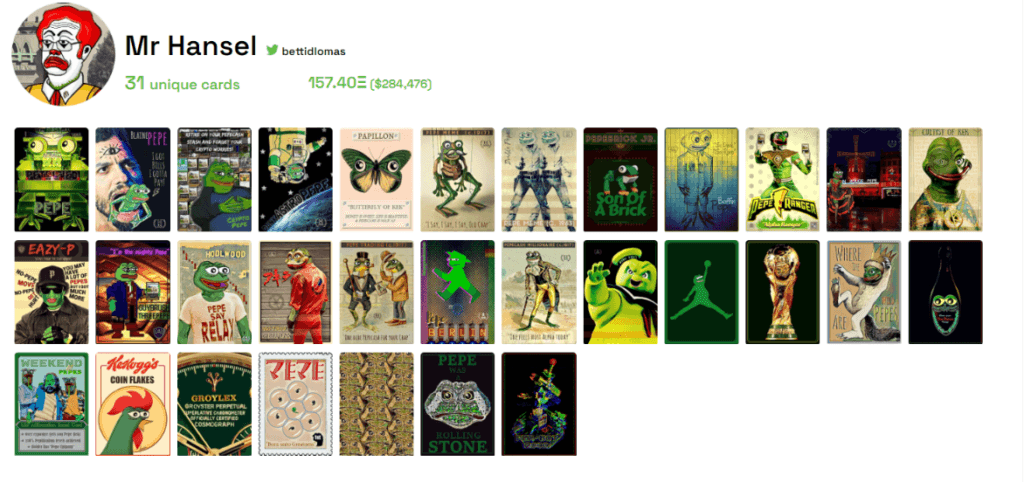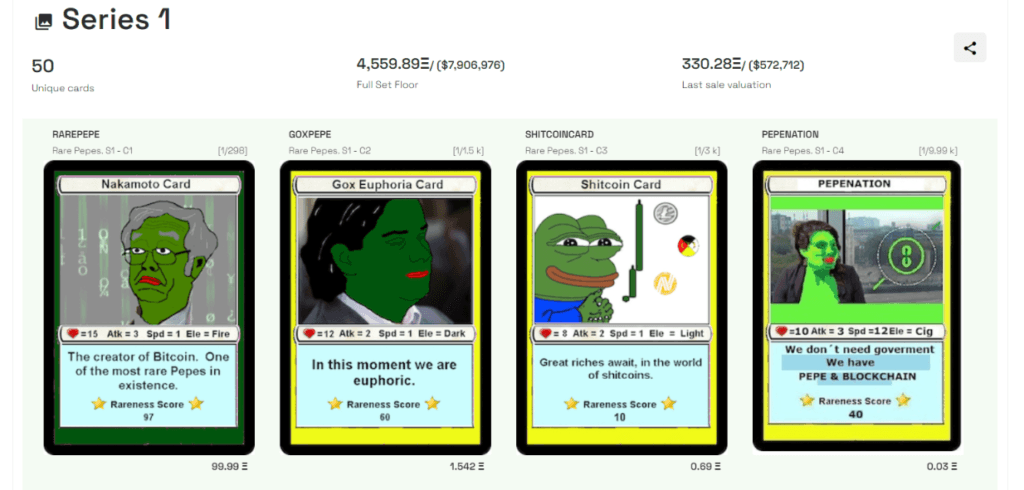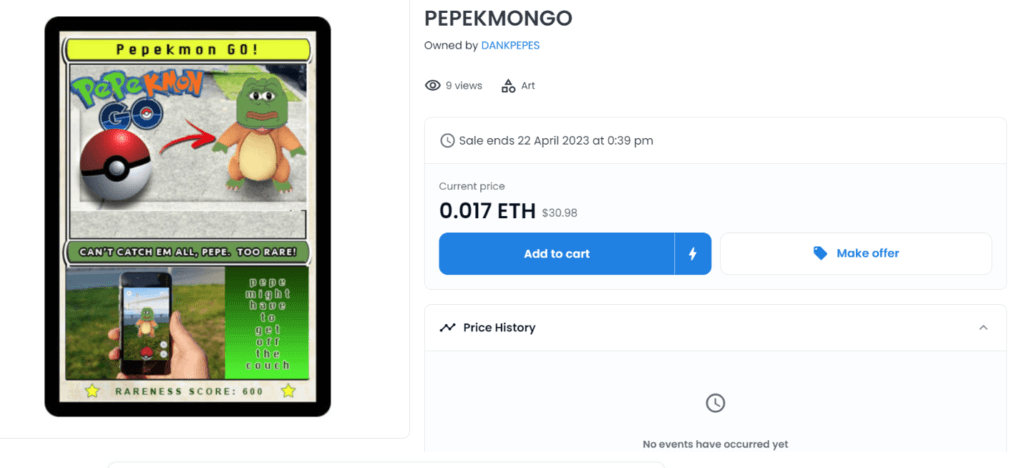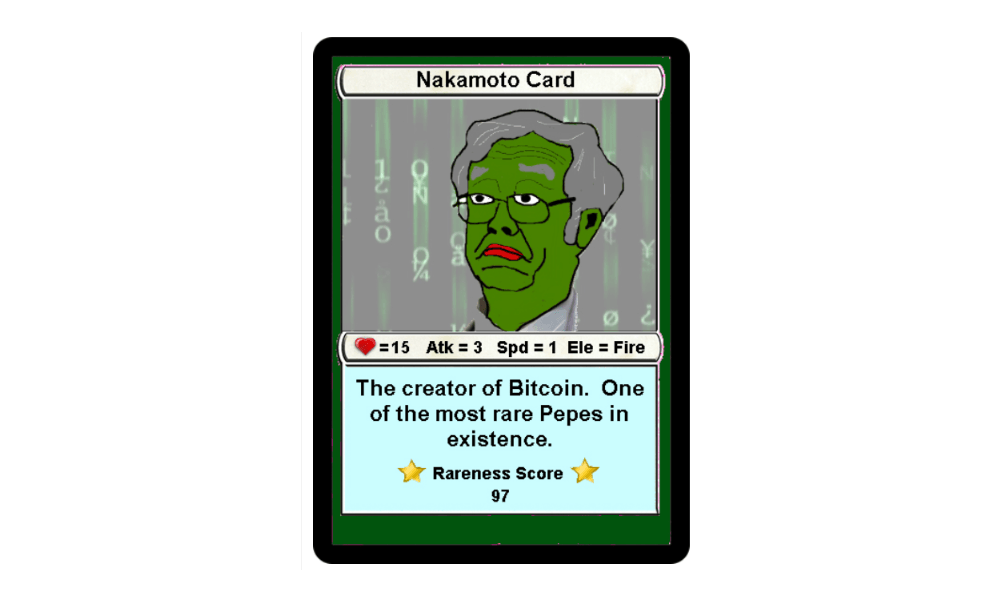Learn everything about the Rare Pepe NFT collection that went from a funny meme to a multi-million dollar Bitcoin NFT collection.
If you’ve spent any time on the internet in the past few years, you’ve probably come across Pepe the Frog. The seemingly uninspiring green frog is one of the most recognized memes on the internet. Although the meme has connotations with the far right, creator Matt Furie designed Pepe to convey feeling good back in 2005.
The Rare Pepes NFT collection immortalized Pepe on the blockchain as a digital collectible using NFT technology. A group of internet culture enthusiasts created the Rare Pepes with the help of several digital artists, and some of these blue-chip NFTs have sold for well over $100k.
This NFT collection isn’t a typical PFP. In fact, the Rare Pepe collection is on the Bitcoin and not the Ethereum blockchain. This post explains the Rare Pepe NFT project by explaining its origins, founders, aims, and how to buy them safely. We also highlight the highest-selling RarePepe NFTs.
Table of Contents
Rare Pepes Explained
The Rare Pepe collection comprises 36 series containing 50 Pepe images with various rarity levels and supply. The Rare Pepes were first minted on the Bitcoin blockchain and have since been wrapped to make them compatible with Ethereum.
The Rare Pepes are the OG NFT meme collection. However, these aren’t your average Ethereum NFTs. To explain them, we first need to take a quick history lesson about this notorious frog.
The origins of Pepe the Frog can be traced back to 2005 when the character appeared in Mark Furie’s comic, “Boy’s Club.” He created Pepe for the comic book strip series Boy’s Club and uploaded it to MySpace. You can follow Furie on Twitter at @Matt_Furie. From 2008 onwards, the Feels Good Man Pepe meme became popular online across messaging boards, forums, and social networking sites like Reddit.

However, in 2015, Pepe was misappropriated by far-right wing groups who used it as part of their online propaganda and also in the run-up to Donald Trump’s presidency.
Furie, uncomfortable with the political connotations surrounding his character, teamed up with the anti-defamation league and kickstarted a social media campaign, #SavePepe, to clean up Pepe’s tarnished image.
The campaign was somewhat successful, and Pepe the Frog went from an alt-right meme to an everything meme. Arguably, the NFT community represents an attempt to reclaim Pepe the Frog meme from proponents of hate speech.
In 2016 the Rare Pepes were minted for the first time on the Bitcoin blockchain, and in 2018, the last of the final Rare Pepe NFT series containing 50 unique cards with varying supplies was minted. You can follow the project on Twitter @pepe_wtf.

Who Created Rare Pepes?
The Rare Pepe NFT project is an open-source collaboration. The project took inspiration from Mark Furie’s Pepe the Frog meme. According to the about page on pepe.wtf, the Pepe Scientists created the collection.
“The Scientists put up a set of rules, aimed at avoiding too much trouble for the community and preserving the playfulness of the collection, and enforced them throughout the years,” according to the pepe.wtf site.
From 2016 to 2018, artists were invited to submit their Rare Pepe designs through the Pepe Directory, where the Scientists had the final say on whether the designs qualified for the subsequent series drop.

We have some information about the artists who helped create the Rare Pepe collections. We’ll give you some details about the top artists, and you can find an extensive list on pepe.wtf.
Mike: Known on Twitter as @myrarepepe, he is a Japan-based artist who created six of the Rare Pepes. Out of his six Pepes, the most notable Pepe he created is the Nakamoto Card which has been traded for over $400k.
Mr. Hansel: Known on Twitter as @bettidlomas, created 31 Rare Pepe cards, including the extremely rare PEPEBRICK, which is a series 10 with a supply of 33 and, as of March 29th, a floor of ETH 41 ($75k).
Rare Scrilla: Known on Twitter as @ScrillaVentura, is a digital artist who has launched various NFT projects, including the Grand Rising collection of musical NFTs. He created 40 Rare Pepe cards, most of which have a hip-hop theme, such as the Jay-Z-themed PEPEGOAT and Tribe Called Quest-themed TRIBE CALLED PEPE.

When Did Rare Pepes Launch?
Around 2015 Pepe the Frog trading cards started to appear on popular auction sites such as eBay, with a collection of 1,200 of them gaining bids of over $90k.
While physical auctions drove serious financial interest, trading cards like these face the issue of forgery. NFTs provided a clear solution as they can be used to create verifiable authentic collections with guaranteed scarcity. Today, anyone can create an NFT on Ethereum or Tezos quickly and easily. Back in 2016, this was not the case.
The anonymous team behind the first 2016 Pepe the Frog NFT collection used Counterparty – a protocol built on top of Bitcoin – to mint and trade the tokens. The Pepes were minted following a trading card template that features a picture of Pepe and some statistics. The 36 series were minted over the course of several years:
- Series 1-9 in 2016
- Series 11-30 in 2017
- 31-36 in 2018

The earliest Rare Pepes were minted in September 2016, and the final pieces were added to the collection in early 2018 with series 36.
What Makes Rare Pepe Unique?
The value of a Rare Pepe is determined partly by the following pieces of information that are available for every Rare Pepe NFT:
- Artists
- Collection
- Series
- Card (the number of the card in the series)
- Supply
- Issuance
Beyond the six factors that impact the value of Rare Pepes, you also need to consider a few more factors that are more challenging to measure. For example, a card’s so-called ‘dankness,’ which refers to the subjective value that you, as a collector, give the art, has a huge impact on its value.
The series and card number tell you the age of the Pepe, and collectors tend to favor older cards. People also value Pepes created by well-known Rare Pepe artists such as Mike.

Take a look at the Nakamoto Card Pepe. This is the oldest Rare Pepes, as it was minted in September 2016 as Card #1 in the first series. It has a supply of 298 and is one of just 14 cards in the Satoshi Nakamoto set. This card was created by Mike, giving it some extra value.
According to pepe.wtf, the Nakomoto Card’s floor price as of March 28th, 2023, is ETH 99 ($174k), and the full supply has a market capitalization of $38 million. In September 2021, a Nakomoto Pepe was sold for ETH 147 ($471k).

Generally, the most valuable Rare Pepes are 1:1 pieces from the earlier series. The rarest and most valuable Pepe is the Homer Pepe. This is a truly unique Pepe from the series two collections created by the artist known as Boost.
NFT collector Peter Kell purchased Homer Pepe in 2018 at Rare Art Labs Digtal Art Festival for $38,500. Kell attracted a lot of criticism for spending so much money on a JPEG. He’d the last laugh in 2021, selling it for ETH 205 ($320k).

Generally, more expensive Rare Pepes have a supply of under 100, while cheaper Pepes have supplies often well over 1000. The WHISKEYPEPE is a series 3 with a supply of 10,000. It was created by the artist John Villar, and as of March 29th, it has a floor price of ETH 0.06 ($111) and a market capitalization of $1 million.

What Does Rare Pepe Do?
Rare Pepes don’t have a fancy metaverse, roadmap, or staking mechanism like other NFTs. NFT fans and historians collect these cards because of their rarity and subjective value. They’re useful as PFPs and within Discord servers too.
How To Buy Rare Pepe
Buying a Rare Pepe NFT isn’t as straightforward as with most collections. As the Rare Pepes were all minted on the Bitcoin blockchain well before Ethereum NFTs became the rage, they can’t be traded like other blue-chip projects.
You’ve got two options when it comes to picking up a Rare Pepe NFT, you can purchase one directly through the Bitcoin blockchain via CounterParty, or you can bypass Bitcoin through the OpenSea Emblem Vault.
If you want to do it the old-school way, you can find a step-by-step guide on the official website, but be warned, it’s complicated and time-consuming. We’ll focus on the Metavult system in this post. Before buying a Rare Pepe, first, make sure you do your own research.
Emblem Vault Explained
Emblem Vault is a multi-asset wallet that allows users to trade NFTs from any blockchain, including Rare Pepes, on Bitcoin. Think of Emblem Vault as an Ethereum NFT box that contains a Rare Pepe. Even though the Pepe NFT is on Bitcoin, the container is on Ethereum, so it can be traded on OpenSea.
Although Emblem Vault has simplified trading Rare Pepes, it still requires a few more steps than buying a standard Ethereum NFT like a Bored Ape.
1. Find A Dank Rare Pepe
The best place to look for Pepes is on pepe.wtf. Once you’ve identified the Pepe of your dreams, check all its statistics, including its recent sales and floor price.
For example, take the Pokenom-go-themed PEPEKMONGO. According to pepe.wtf, as of March 29th, this NFT has a floor price of just ETH 0.007 ($13) and a supply of over 3 million, making it a very common Pepe.

2. Rare Pepe Directory
Once you’ve identified a sufficiently ‘dank’ Rare Pepe and found it in the Emblem Vault, the first thing you need to do is check that it’s not a fake. To check that your Pepe is an original, visit the Rare Pepe Directory.
Search for your Pepe, in this case, PEPEKMONGO using the Rare Pepe Directory search box. Check that the details of the Emblem Vault Pepe match those shown by the Directory.
3. Submit Offer
What you may notice is that the floor price on pepe.wtf and the actual price on OpenSea are not the same. As the Rare Pepe collection is not very liquid, these disparities occur, and as a result, the listed Emblem Vault price is normally too high.
For this reason, instead of using the ‘buy now’ feature on OpenSea, submit an offer below the asking price.

If you aren’t sure about how to use OpenSea, here’s a quick guide for you to follow:
- Get a Crypto Wallet: Get an ETH-compatible crypto wallet like MetaMask.
- Connect to Marketplace: Visit the Emblem Vault OpenSea page and connect your wallet.
- Explore: Browse the collection and find the Rare Pepe you’ve researched and cross-checked for originality.
- Submit Offer: Place an offer below the asking price for your Rare Pepe.
NFTs are very volatile assets, so always do your own research.
The Future of Rare Pepe NFT
The Rare Pepe NFT collection is the ultimate meme collection. Even though some of these blockchain-based trading cards have sold for small fortunes, they don’t have any real-world utility. They’re popular with NFT historians and collectors. The project has also inspired several other Pepe the Frog NFT projects.


